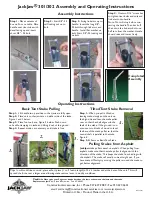
SPECIFICATIONS
SPECIFICATIONS
SPECIFICATIONS
SPECIFICATIONS
SPECIFICATIONS
Instruction Manual
www.hannainst.com
Dear Customer,
Thank you for choosing a Hanna Product.
Please read the instruction sheet carefully before using the
test kit. It will provide you with the necessary information
for correct use of the kit. If you need additional information,
do not hesitate to e-mail us at [email protected].
Remove the chemical test kit from the packing material and
examine it carefully to make sure that no damage has
occurred during shipping. If there is any noticeable dam-
age, notify your Dealer or the nearest Hanna office
immediately.
Each kit is supplied with:
• HI 93702-0 Reagent, packets (50 pcs);
• HI 3856-0 Reagent, packets (50 pcs);
• Deionized Water, 1 bottle (230 mL)
• 1 long path color comparator cube;
• 1 color comparator cube;
• 1 plastic test tube (14 mL) with screw cap;
• 1 plastic pipette (3 mL).
Note:
Any damaged or defective item must be returned in
its original packing materials.
SPECIFICATIONS
SPECIFICATIONS
SPECIFICATIONS
SPECIFICATIONS
SPECIFICATIONS
HI 38075
Copper
Low and High Range
Test Kit
ISTR38075 02/00 PRINTED IN ITALY
Range
0 to 0.25 mg/L (ppm)
0 to 6.0 mg/L (ppm)
Smallest Increment
0.05 ppm
1.2 ppm
Analysis Method
Colorimetric, bicinchoninate
Sample Size
25 mL
2.5 mL
Number of Tests
100 (50 for each range)
Case Dimensions
230x59x70 mm (9.0x2.3x2.8")
Shipping Weight
555 g (19.6 oz.)
SIGNIFICANCE AND USE
SIGNIFICANCE AND USE
SIGNIFICANCE AND USE
SIGNIFICANCE AND USE
SIGNIFICANCE AND USE
CHEMICAL REACTION
CHEMICAL REACTION
CHEMICAL REACTION
CHEMICAL REACTION
CHEMICAL REACTION
Copper salts react with bicinchoninate reagent to form a
purple product in a neutral buffered condition. The amount
of color developed is proportional to the concentration of
copper present in the aqueous sample.
Copper is an essential trace element in human diet (the
daily requirement is around 2.0 mg) and a factor in plant
metabolism. Copper salts are used in water supply systems
to control biological growth in reservoirs. High concentrations
on the other hand are toxic and corrosion of copper alloys in
pipe fittings may introduce considerable quantities into the
water supplies.
Note:
mg/L is equivalent to ppm (parts per million).
INSTRUCTIONS
INSTRUCTIONS
INSTRUCTIONS
INSTRUCTIONS
INSTRUCTIONS
READ THE ENTIRE INSTRUCTIONS BEFORE USING THE KIT
• To measure copper in the
0-0.25 range
, fill the long
path comparator cube with sample up to the 25 mL
mark.
The chemicals contained in this kit may be hazardous if
improperly handled. Read the relevant Health and Safety
Data Sheet before performing this test.
HEALTH AND SAFETY
HEALTH AND SAFETY
HEALTH AND SAFETY
HEALTH AND SAFETY
HEALTH AND SAFETY
REFERENCES
REFERENCES
REFERENCES
REFERENCES
REFERENCES
Adaptation of EPA approved method.
• Add 1 packet
of HI 3856-0
reagent.
• Replace the cap and mix by
inverting the cube several times.
• Wait 45 seconds to allow color to
develop.
• Determine which
color best matches
the solution in the
cube and read
the result directly
in mg/L (ppm) of
Copper.
• It is better to
match the color
with a white
sheet placed at
about 10 cm (4") behind the comparator.
• To measure copper in the
0-6.0
range
, use the pipette to fill the
plastic test tube with 2.5 mL of
sample, up to the mark.
• Add 3.5 mL of
Deionized Water to
reach the 6 mL
mark. Replace the
cap and swirl to
mix. This is the
diluted sample.
• Pour then 5 mL of the di-
luted sample from the tube
to the color cube (up to the
mark).
• Add 1 packet of HI 93702-0, replace
the cap and shake well.
• Wait 45 seconds to
allow color to develop.
• Determine which color matches the solution in the vessel.
Multiply the result by 2.4 to obtain mg/L (or ppm) of
Copper in the sample.
• It is better to match the color with a white sheet placed
at about 10 cm (4") behind the comparator.
2.5 mL
25 mL



















